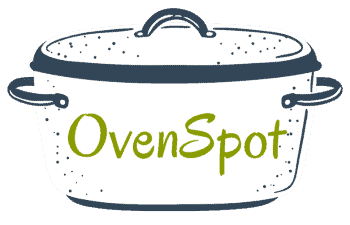Carnivore Diet Meal Plan for Beginners: 7 Days of Simple Meals
Starting the Carnivore Diet can feel both exciting and a little overwhelming especially if you’re coming from years of mixed meals, snacks, and complicated ingredient lists. The good news? This way of eating is as simple as it gets.
This 7-day carnivore diet meal plan is designed especially for beginners who want to see what eating only animal foods feels like without overthinking every bite. You’ll find easy, satisfying meals made from real food “meat, eggs, fish, butter” the same foods that kept our grandparents strong and healthy long before “diet” became a buzzword.
Over the next week, you’ll learn what to eat, how much, and how to make it all fit into your real life. No meal prep marathons or complicated macros just straightforward eating that fuels your body and lets your appetite guide you naturally.
You’ll also find:
- A simple grocery list (so you know exactly what to buy)
- Easy recipes you can cook in under 20 minutes
- Macro and electrolyte tips to help your body adapt smoothly
If you’re ready to ditch food rules and rediscover how good simplicity feels, this plan is your starting point. Save it, print it, or pin it to your Carnivore board your first week of healing starts here.
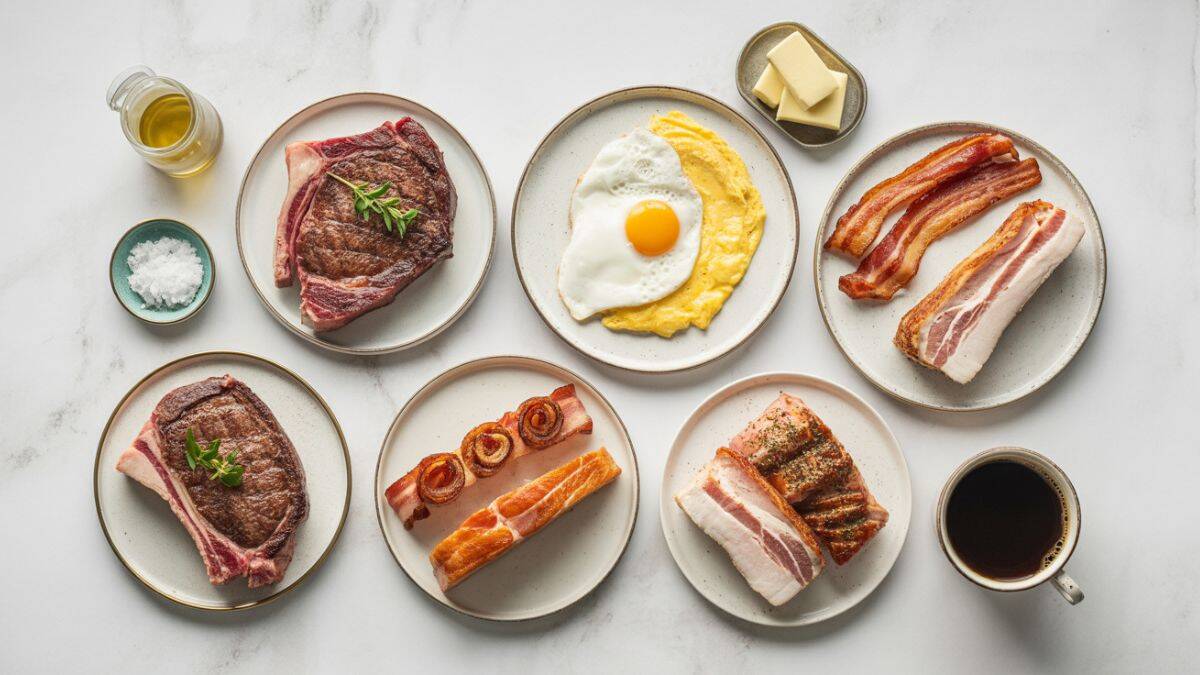
What to Expect During Your First Week
Your first week on the Carnivore Diet (Affiliate) is all about adjustment both physically and mentally. You’re teaching your body to switch from using carbohydrates for fuel to burning fat for energy. This shift, known as fat adaptation, can take anywhere from a few days to a few weeks, and everyone experiences it a little differently.
In the beginning, you may notice:
- Lower energy or brain fog as your body learns to use fat efficiently.
- Sugar or carb cravings completely normal as old habits fade.
- Changes in digestion, such as constipation or looser stools, while your gut adapts.
- Electrolyte shifts that can cause light headaches or muscle cramps if not managed.
Don’t worry these early symptoms are temporary and easily eased with a few small steps:
- Stay hydrated: Drink plenty of water throughout the day.
- Salt your food generously: Sodium, potassium, and magnesium help balance hydration and reduce fatigue.
- Eat enough: Don’t restrict calories or portion sizes right now. Eat until comfortably full your appetite will naturally regulate over time.
You don’t need to count macros or weigh portions. Just focus on eating real animal foods whenever you’re hungry and stopping when you’re satisfied. As your body adjusts, energy levels stabilize, cravings disappear, and mental clarity often improves dramatically.
Think of this first week as your reset button a simple, powerful way to reconnect with how your body feels when it’s fueled by nutrient-rich, whole food.
Pro Tip: Keep a small container of high-quality salt (like Redmond Real Salt (Affiliate) or Himalayan salt) with you. Sprinkle a pinch into your water or onto meals to help your body stay balanced during the first week.
The Carnivore Grocery List for Week One
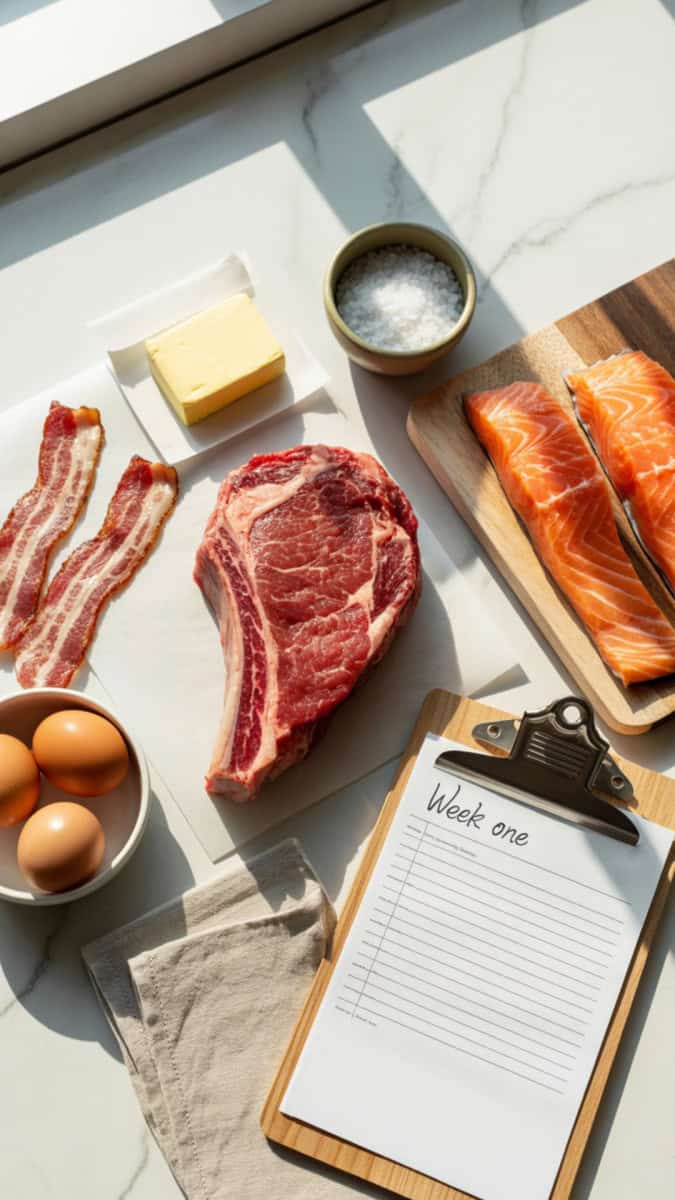
Before you start your first week, stock up on simple, whole ingredients that make cooking fast and stress-free. The Carnivore Diet keeps things beautifully uncomplicated no labels to read, no long ingredient lists, just real food your body recognizes.
Below is your 7-day grocery list divided into easy categories. You don’t need everything on this list right away just choose the meats and fats you enjoy most and rotate them through the week.
Beef & Red Meat
- Ground beef (80/20 blend for balanced fat and flavor)
- Ribeye steaks or sirloin
- Chuck roast (great for slow cooking)
- Beef liver or heart (optional for added nutrients)
- Beef tallow or suet (for cooking or frying)
Pork
- Pork chops
- Bacon (check labels for no added sugar)
- Pork belly or pork roast
- Ground pork or sausage (simple ingredients only)
Poultry
- Chicken thighs or drumsticks (skin-on for extra fat)
- Chicken wings
- Whole chicken (great for roasting and leftovers)
Seafood
- Salmon (fresh or frozen fillets)
- Sardines (in water or olive oil)
- Shrimp, scallops, or white fish
- Canned tuna (check label for plain varieties)
Animal Fats & Add-Ons
- Butter or ghee
- Beef tallow, duck fat, or lard
- Eggs (always have extra!)
- Hard cheeses (optional if tolerated Parmesan, cheddar, etc.)
Pantry & Essentials
- Salt (Himalayan, sea salt, or Redmond Real Salt)
- Sparkling or still water
- Electrolyte mix (unsweetened)
- Black coffee or plain tea (optional)
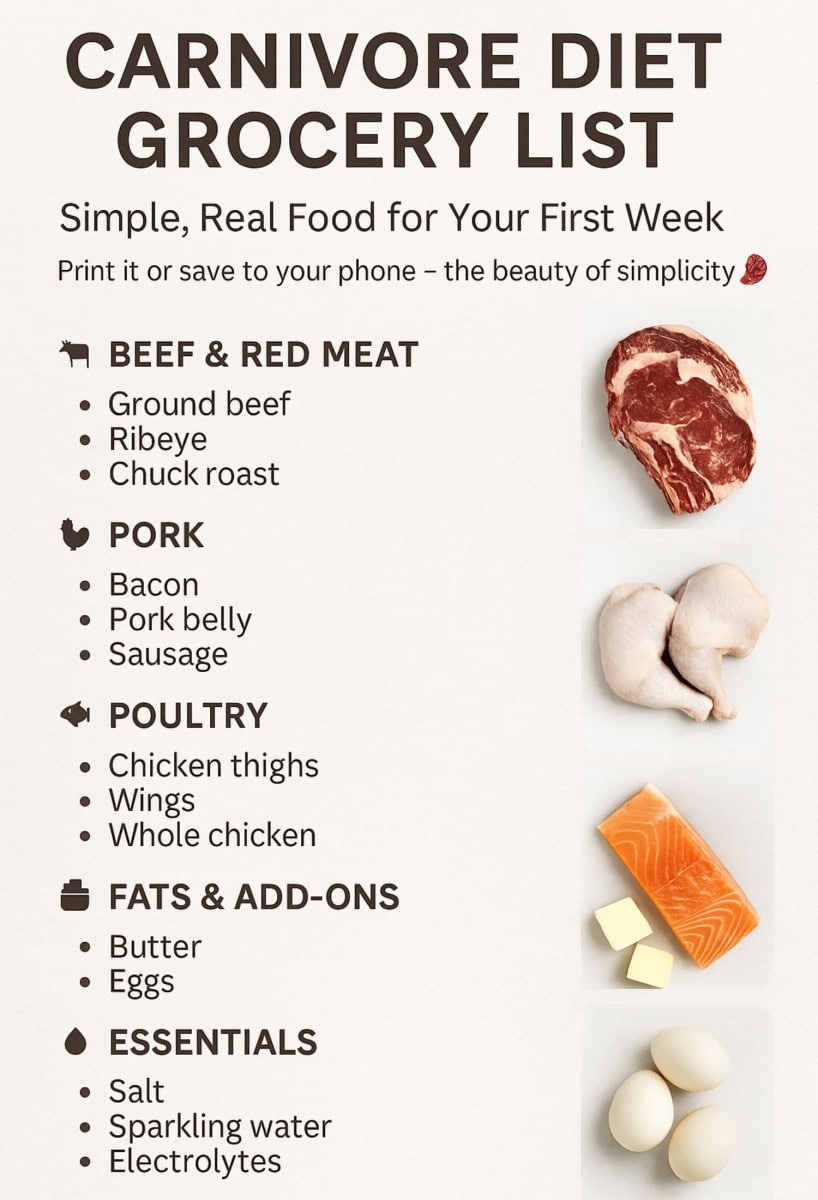
Quick Tip: Start your week with one fatty cut (like ribeye or pork belly) and one leaner cut (like chicken or sirloin) on hand. Mixing them keeps meals balanced and satisfying while helping you learn what ratio of fat to protein feels best for your body.
7-Day Carnivore Meal Plan
This 7-day plan keeps things simple, affordable, and satisfying perfect for beginners easing into the Carnivore lifestyle. Each day includes breakfast, lunch, and dinner ideas you can mix and match based on what’s in your fridge.
You don’t need to follow it perfectly the goal is to build comfort with this new way of eating and learn which meats and cuts make you feel your best.
Day 1
Breakfast: Scrambled eggs cooked in butter
Lunch: Ground beef patties with melted cheese
Dinner: Ribeye steak cooked in its own pan drippings
Quick Tip: Add a little extra butter or tallow to your plate if you feel hungry between meals your body’s still adjusting to using fat for fuel.
Day 2
Breakfast: Crispy bacon and fried eggs
Lunch: Tuna patties cooked in beef tallow or butter
Dinner: Pork chops with golden, crispy fat edges
Optional Snack: Bone broth or leftover bacon
Quick Tip: When in doubt, cook extra meat at dinner leftovers make perfect lunches or snacks for the next day.
Day 3
Breakfast: Omelet made with leftover steak pieces
Lunch: Chicken thighs roasted with skin on
Dinner: Pan-seared salmon with melted butter drizzle
Quick Tip: Notice how full you feel after each meal. Some people need more fat early on to avoid energy dips in the afternoon.
Day 4
Breakfast: Ground beef hash (just meat, butter, and salt)
Lunch: Pork belly slices or crispy pork roast
Dinner: Chuck roast slow-cooked in broth or tallow
Quick Tip: Save the drippings or broth they’re full of electrolytes and flavor. Use them to reheat meats or sip warm between meals.
Day 5
Breakfast: Fried eggs and bacon
Lunch: Shrimp sautéed in ghee or butter
Dinner: Ribeye or sirloin steak
Quick Tip: Don’t fear repetition simplicity helps your digestion reset and makes meal prep easier during your first week.
Day 6
Breakfast: Beef liver and eggs (optional nutrient boost)
Lunch: Chicken wings, grilled or air-fried
Dinner: Pork roast with crackling
Quick Tip: Not a fan of liver? Start small add just one bite alongside another meat to build the habit without overwhelm.
Day 7
Breakfast: Egg muffins (eggs + beef mince baked together)
Lunch: Leftover roast topped with melted butter
Dinner: Grilled salmon or ribeye steak your choice!
Quick Tip: Celebrate your first week you’ve made it! Reflect on how you feel, note your energy changes, and plan your next week around your favorite meals.
Weekly Summary
By the end of week one, you’ll likely notice steadier energy, fewer cravings, and better focus. The beauty of this plan is how easy it becomes eat real food, salt it well, and enjoy.
Macro Tips for the Carnivore Diet
One of the most refreshing parts of the Carnivore Diet is that you don’t need to weigh, track, or count anything unless you want to. Your body is remarkably good at telling you how much to eat once you start feeding it the right foods.
That said, understanding the basics of macros (protein, fat, and carbs) helps you feel confident that you’re nourishing your body well.
Protein: Your Building Block
Protein is the foundation of every meal. It helps maintain muscle, supports recovery, and keeps you satisfied.
- Aim for about 1 gram of protein per pound of body weight per day as a starting point.
- Choose nutrient-dense sources like beef, eggs, chicken thighs, or salmon.
- Don’t worry about hitting this number exactly use it as a ballpark guide.
Fat: Your Main Energy Source
Fat is your new fuel on the Carnivore Diet. Without carbs, your body runs primarily on fat for energy.
- Use butter, ghee, or tallow generously in cooking.
- Choose fattier cuts (like ribeye or pork belly) if you’re feeling hungry or low on energy.
- Don’t be afraid of the extra calories your body uses this fat efficiently.
Carbs: Practically Zero
The Carnivore Diet eliminates carbohydrates, allowing your metabolism to burn fat for fuel.
- You’ll stay full longer, reduce blood sugar swings, and improve energy stability.
- Even trace carbs (like in eggs or cheese) won’t knock you off track.
Electrolytes: Don’t Skip Them

LMNT Sparkling Electrolyte Drink – Citrus Salt
Buy Now →
LMNT Zero Sugar Electrolytes – Variety Pack
Buy Now →
LMNT Zero Sugar Electrolytes – Raspberry Salt
Buy Now →(Affiliate)
When carbs drop, your body flushes out more water and minerals. Replenishing them helps you feel great.
- Add salt to every meal.
- Consider magnesium or potassium supplements if you feel lightheaded or get muscle cramps.
- Sip on bone broth it’s a natural electrolyte boost.
Quick Tip: If you ever feel sluggish or foggy, it’s rarely “too much fat” it’s usually not enough salt or water. Add a pinch of salt to a glass of water and see how quickly your energy perks back up.
Easy Carnivore Recipes from the Plan
You don’t need fancy ingredients or a chef’s skills to make delicious Carnivore meals just meat, salt, and heat. Below are a few simple recipes inspired by your 7-day plan. Each one uses minimal ingredients and delivers big flavor.
As you explore, you can link these to individual recipe posts on OvenSpot for readers who want step-by-step instructions or cooking method variations (stovetop, oven, air fryer, or grill).
Butter-Basted Ribeye Steak
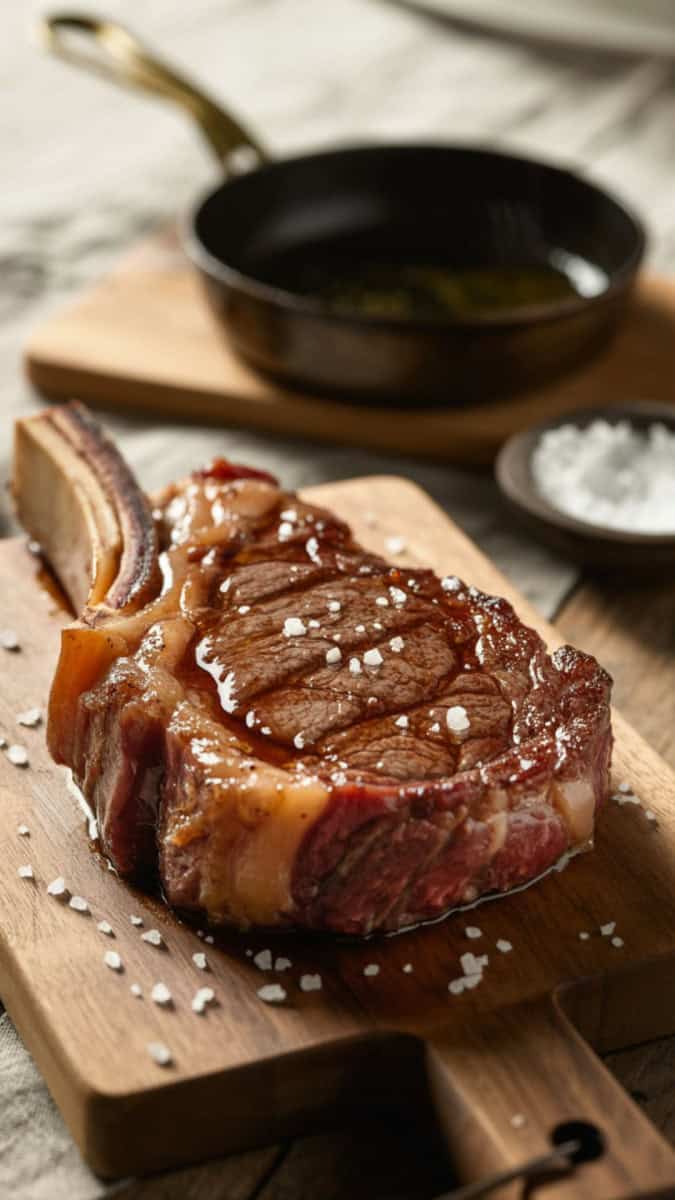
A perfect beginner meal rich, flavorful, and satisfying. Sear your ribeye in a hot pan with butter until the edges are crisp and golden. Spoon the melted butter over the steak as it cooks for an extra dose of flavor and fat. Get the full recipe right here on OvenSpot for butter basted ribeye steak!
Cheesy Egg Muffins

Whisk eggs with ground beef and shredded cheese (if tolerated), pour into muffin tins, and bake. Great for meal prep or on-the-go breakfasts that stay true to Carnivore simplicity. Get the full recipe right here on OvenSpot for cheesy egg muffins!
Crispy Pork Belly Strips
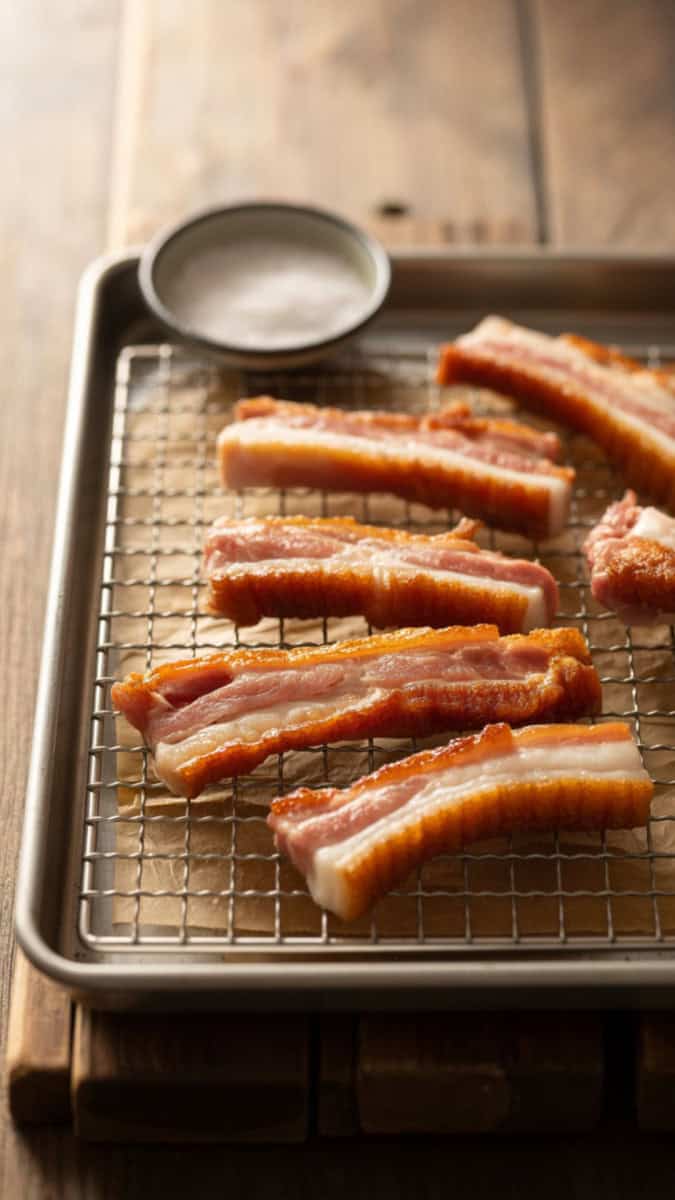
Score the skin, season with salt, and roast until bubbly and golden. These are perfect as a meal or crunchy snack between larger servings. Get the full recipe right here on OvenSpot for crispy pork belly strips!
Pan-Seared Salmon with Butter Sauce
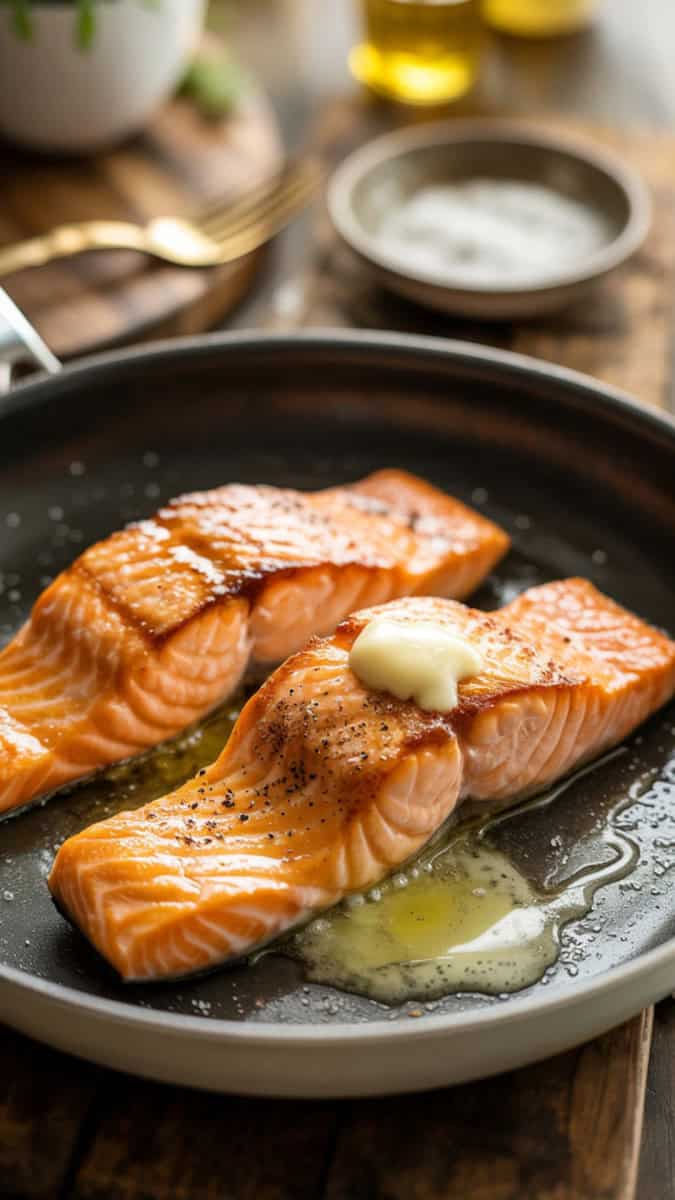
Cook salmon fillets skin-side down until crisp, then finish with melted butter and a pinch of salt. A simple, nutrient-packed dinner rich in omega-3s. Get the full recipe right here on OvenSpot for pan seared salmon!
Simple Ground Beef Bowls
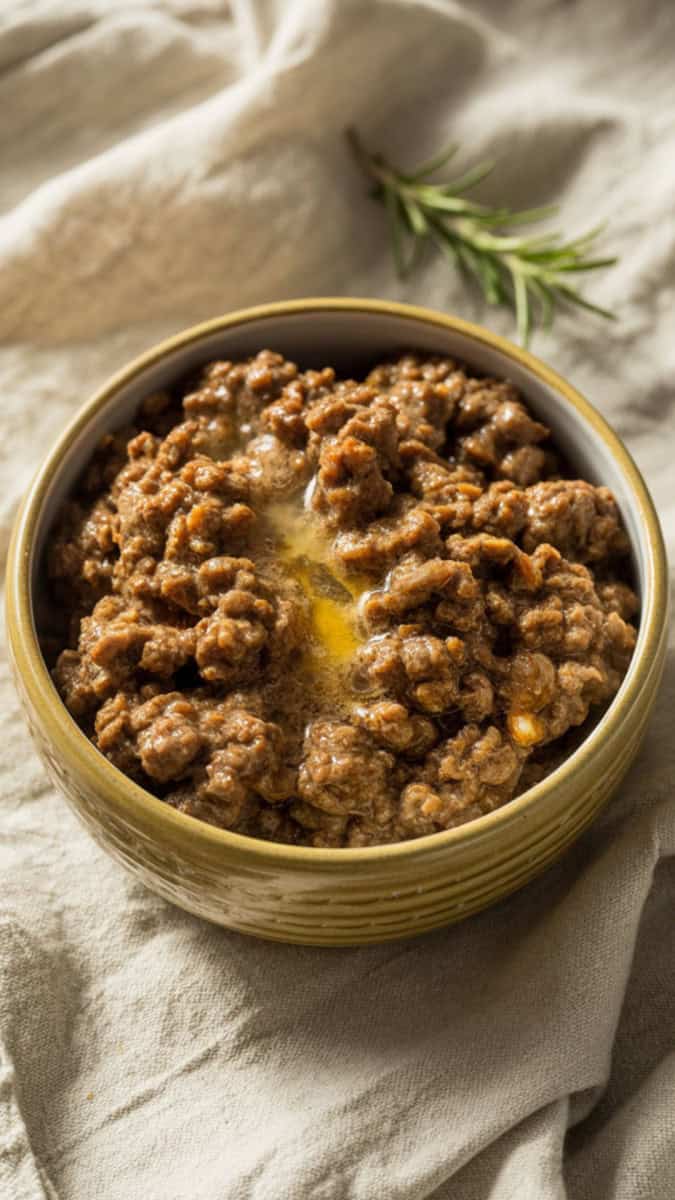
Brown ground beef in tallow or butter, season with salt, and serve as-is or shape it into patties for quick lunches. You can’t go wrong with this Carnivore classic. Get the full recipe right here on OvenSpot for ground beef bowls!
Quick Tip: Cook double portions when you can. Carnivore leftovers reheat beautifully, and having ready-to-eat meals in your fridge makes it easy to stay on track even on busy days.
Tips for Staying on Track
Starting something new especially a diet that challenges old habits can take a bit of adjusting. But the Carnivore Diet is refreshingly simple once you find your rhythm. The key is preparation, mindset, and flexibility.
Here’s how to make your first few weeks smoother and more enjoyable.
Keep Meat Prepped and Visible
If you’ve got cooked meat ready in the fridge, you’re far less likely to reach for anything else. Batch-cook ground beef, chicken thighs, or roasts and store them in clear containers. Seeing them reminds you there’s always something easy to eat.
Cook Once, Eat Twice
Double your dinner portions and set aside the extra for the next day’s lunch or snack. Carnivore leftovers taste just as good reheated sometimes better.
Don’t Skimp on Salt
Fatigue, headaches, or low energy are often signs of low electrolytes, not a failing diet. Keep salt handy and sprinkle it on every meal, or stir a pinch into your water once or twice a day.
Rotate Meats to Avoid Boredom
Even though this way of eating is simple, variety keeps your taste buds happy. Alternate between beef, pork, chicken, and seafood. Different textures and flavors make sticking with the plan effortless.
Listen to Your Body
Some days you’ll be hungrier than others that’s normal. Eat until you’re satisfied, and don’t worry about calories. Over time, your appetite naturally balances itself.
Quick Tip: Keep a small notebook or phone note to track how you feel after meals during your first few weeks. You’ll start noticing patterns which meats give you energy, which help you sleep better, and how quickly cravings fade. That’s your body’s feedback system working for you.
Common Beginner Questions (Mini FAQ)
Starting the Carnivore Diet often brings up the same handful of questions especially during that first week. Here are simple, no-fuss answers to help you feel confident as you settle in.
Can I drink coffee or tea?
Yes many Carnivore eaters still enjoy coffee or plain tea, especially in the beginning. Over time, some choose to reduce or eliminate caffeine to see how their body feels. Just skip sweeteners and creamers that add carbs or sugar. Get my creamy carnivore coffee recipe!
Do I need supplements?
Not necessarily. The Carnivore Diet provides most nutrients from animal foods. However, you may benefit from magnesium, potassium, or electrolytes during the first few weeks while your body adjusts.
What if I get constipated or bloated?
This is common when transitioning from high-fiber eating to zero-fiber meals. Drink plenty of water, salt your food well, and give your gut time to adjust it usually resolves within a few days. Adding bone broth can also help ease digestion.
How much should I eat per meal?
As much as it takes to feel comfortably full. Don’t restrict or portion-control at first your body is relearning its natural hunger and fullness cues. Over time, you’ll notice your appetite stabilizing. Try this next: “Carnivore Diet for Beginners: What to Expect in the First 30 Days”
Why do I feel tired or lightheaded?
That’s your body adapting to burning fat for fuel. Make sure you’re drinking enough water and salting your meals generously. Energy usually stabilizes after a few days once your electrolytes rebalance.
Do I have to eat organ meats?
No they’re optional. Liver and heart are nutrient-dense, but not required for success. You can add them later once you’ve settled into the basics.
Quick Tip: If you ever feel stuck, go back to the foundation: meat, salt, water, rest. Keep it that simple. Most bumps in the road smooth out once you return to those basics.
Wrapping Up: Your First Step to Healing
You’ve just completed your first week on the Carnivore Diet that’s something to celebrate. By now, you’ve seen how simple, satisfying, and grounding this way of eating can be. You’re learning to listen to your body, fuel it with real food, and let go of unnecessary diet rules.
The beauty of this lifestyle is that it continues to get easier. Cravings fade, energy rises, and your meals become second nature. Each bite of steak, salmon, or eggs is a small step toward healing not just physically, but mentally too.
If you’re ready to keep the momentum going, here’s what to do next:
- Continue to Week 2: Stay consistent and explore new cuts of meat or recipes.
- Read next: Common Carnivore Diet Mistakes and How to Avoid Them
- Learn more: Carnivore Diet Food List: Beef, Pork, Seafood & More
- Subscribe: Join the Carnivore Diet Newsletter for printable meal plans, grocery lists, and simple recipes sent straight to your inbox.
Remember progress isn’t about perfection; it’s about consistency. The more you simplify your food, the more your body can focus on what it does best: healing and thriving.
Quick Tip: Take a photo of your first week’s grocery haul or favorite meal. It’s fun to look back in a few weeks and see just how far you’ve come not just in your food choices, but in your confidence too.

Michelle
Hi, I’m Michelle, the founder, owner, author, and editor of OvenSpot. My passion for one-pot cooking commenced when I was working to prepare cafeteria lunches for school students. I am now on a mission to assist you in choosing the cooking pot or appliance you will use daily. As well as in-depth information to assist you in using and caring for your cookware and appliances. Along with the yummy recipes I use at home.
Questions? Reach out to Michelle at [email protected]
